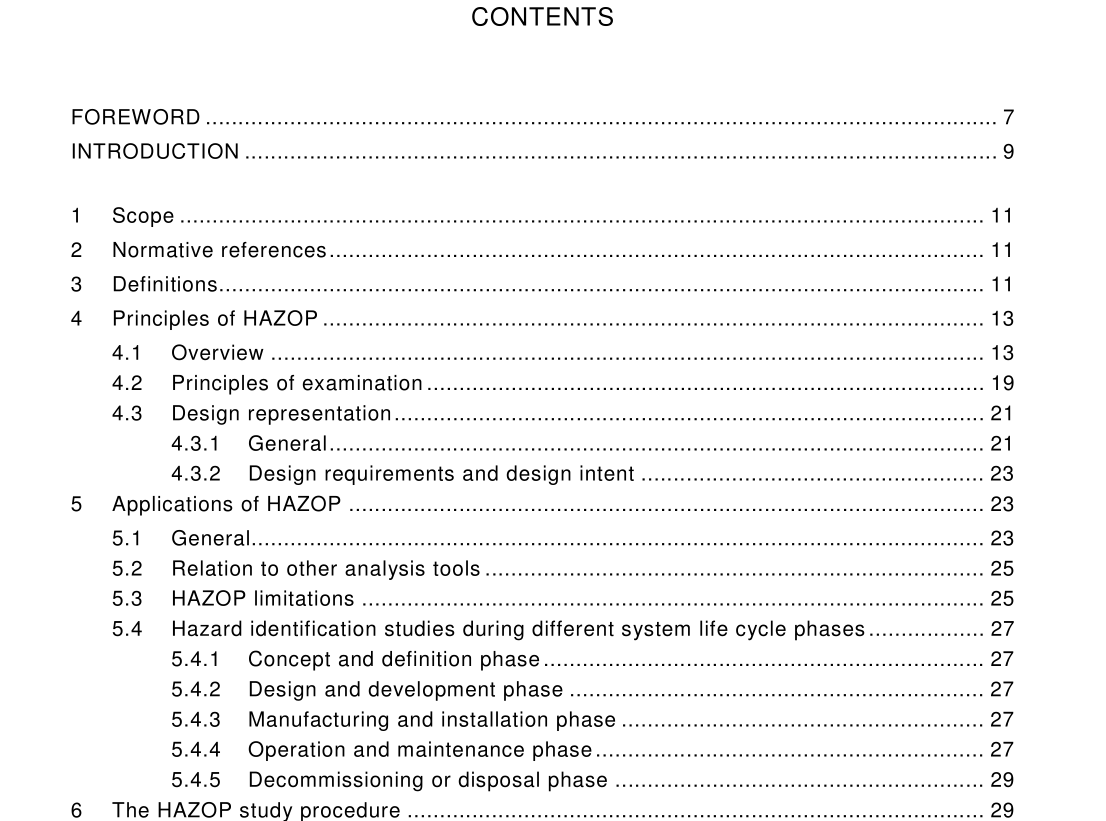IEC 61882 pdf download

IEC 61882 pdf download.Hazard and operability studies (HAZOP studies) – Application guide
1 Scope
This International Standard provides a guide for HAZOP studies of systems utilizing the specific set of guide words defined in this document. It also gives guidance on application of the technique and on the HAZOP study procedure, including definition, preparation, examination sessions and resulting documentation and follow-up. Documentation, as well as a broad set of examples encompassing various industries, illustrating HAZOP examination is also provided.
2 Normative references
The following normative documents contain provisions which, through reference in this text, constitute provisions of this International Standard. For dated references, subsequent amendments to, or revisions of, any of these publications do not apply. However, parties to agreements based on this International Standard are encouraged to investigate the possibility of applying the most recent editions of the normative documents indicated below. For undated references, the latest edition of the normative document referred to applies. Members of IEC and ISO maintain registers of currently valid International Standards. IEC 60300-3-9, Dependability management – Part 3: Application guide – Section 9: Risk analysis of technological systems IEC 60812, Analysis techniques for system reliability – Procedure for failure mode and effects analysis (FMEA) IEC 61025, Fault tree analysis (FTA) IEC 61160, Formal design review
3 Definitions
For the purposes of this International Standard, definitions contained in IEC 60050(191) as well as the following terms and definitions apply: 3.1 characteristic qualitative or quantitative property of an element NOTE Examples of characteristics are pressure, temperature, voltage. 3.2 design intent designer’s desired, or specified range of behaviour for elements and characteristics 3.3 deviation departure from the design intent 3.4 elem ent constituent of a part which serves to identify the part’s essential features NOTE The choice of elements may depend upon the particular application, but elements can include features such as the material involved, the activity being carried out, the equipment employed, etc. Material should be considered in a general sense and includes data, software, etc. 3.5 guide w ord word or phrase which expresses and defines a specific type of deviation from an element’s design intent 3.6 harm physical injury or damage to the health of people or damage to property or the environment 3.7 hazard potential source of harm 3.8 part section of the system which is the subject of immediate study NOTE A part may be physical (e.g. hardware) or logical (e.g. step in an operational sequence). 3.9 risk combination of the probability of occurrence of harm and the severity of that harm
4 Principles of HAZOP
4.1 O verview A HAZOP study is a detailed hazard and operability problem identification process, carried out by a team. HAZOP deals with the identification of potential deviations from the design intent, examination of their possible causes and assessment of their consequences. Key features of HAZOP examination include the following. • The examination is a creative process. The examination proceeds by systematically using a series of guide words to identify potential deviations from the design intent and employing these deviations as “triggering devices” to stimulate team members to envisage how the deviation might occur and what might be the consequences. • The examination is carried out under the guidance of a trained and experienced study leader, who has to ensure comprehensive coverage of the system under study, using logical, analytical thinking. The study leader is preferably assisted by a recorder who records identified hazards and/or operational disturbances for further evaluation and resolution.• The examination relies on specialists from various disciplines with appropriate skills and experience who display intuition and good judgement. • The examination should be carried out in a climate of positive thinking and frank discussion. When a problem is identified, it is recorded for subsequent assessment and resolution. • Solutions to identified problems are not a primary objective of the HAZOP examination, but if made they are recorded for consideration by those responsible for the design. HAZOP studies consist of four basic sequential steps, shown in Figure 1.









